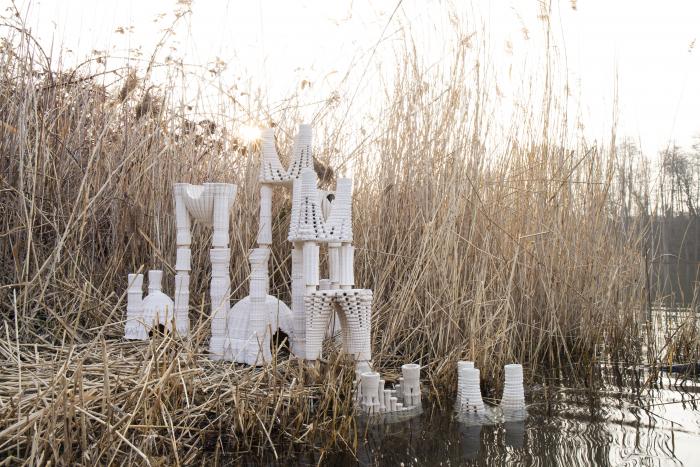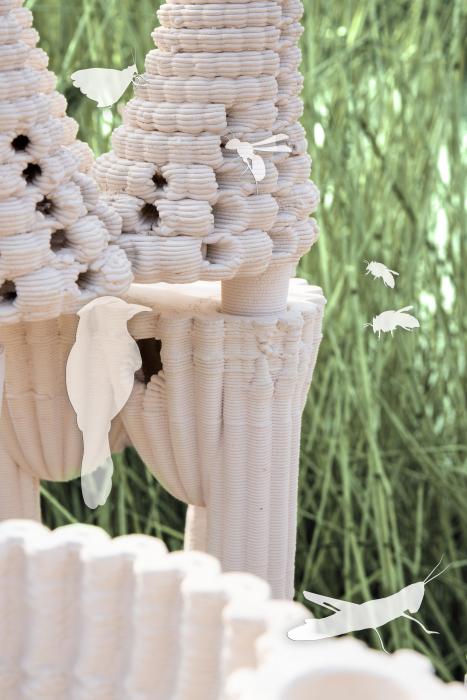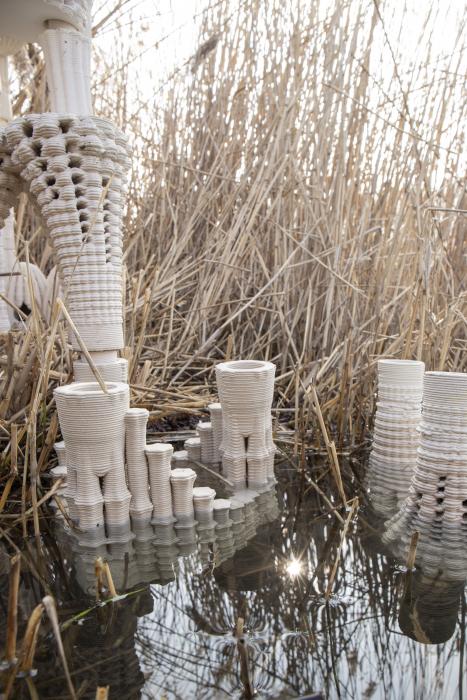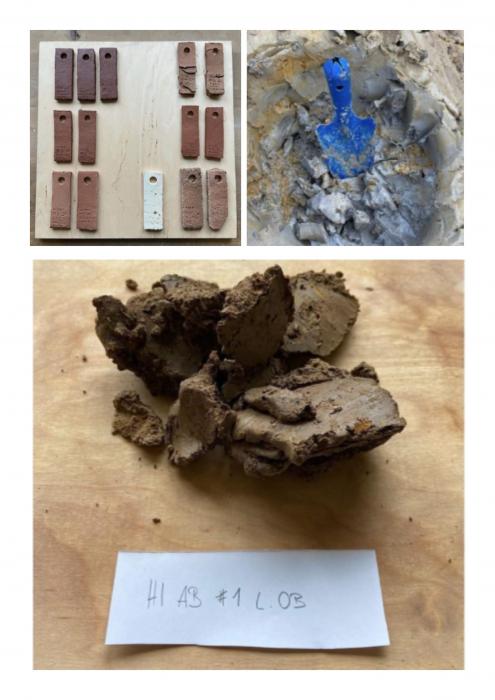Il Symbiotic Spaces Collective è un progetto multidisciplinare il cui obiettivo è salvaguardare e arricchire la fauna selvatica nei contesti urbani, sfruttando la tecnologia di stampa 3D open source e i materiali locali, a partire dall’argilla. Le strutture del SSC sono progettate per un’ampia varietà di specie, come animali acquatici, piccoli mammiferi, insetti e uccelli. Le forme delle strutture prendono vita dall’osservazione delle architetture non umane e naturali. Il progetto nasce dalle crescenti preoccupazioni per la biodiversità e il rapporto tra l’uomo e le creature che tengono in vita i nostri ecosistemi.
The transdisciplinary project Symbiotic Spaces Collective (SSC) runs in tangent with the motifs under categorie ’Reconnecting with nature’’ of the Bauhaus 2022 Prize. SSC explores and questions today's living situations thus driving forward a shift for a life-centered rather than human-centered togetherness. Who actually inhabits a city? "Symbiotic Spaces" is driven by this question and creates places for various species such as amphibians, fish, wild bees, small mammals, birds and plants while cohabiting with humans. The work is motivated by crucial questions about the future of biodiversity and species extinction, the nature of technology through the use of sustainable materials and the relationship of humans to the beautifully diverse critters that keep our ecosystems alive. Digital tools such as 3D printing and organic algorithms are used to incorporate technology into the symbiotic process between species.
Please highlight how the concept/idea can be exemplary in this context
„Protect, restore and promote sustainable use of terrestrial ecosystems (...)“ is the 15th goal of the Global Goals For Sustainable Development by the UN. The Symbiotic Spaces Collective is working on the alignment to this goal.
At the same time one side effect of human civilization is the decreasing of biodiversity on a global scale. In an interview with the LiveScience Magazine, the renowned Biologist Gerardo Ceballos states that we are in the midst of the 6th Great Mass Extinction of species in the earth‘s history. This one is caused by the human species and by far the worst of all time. This also includes insects, vertebrates like amphibia, mammals and birds.
One hypothesis of Symbiotic Spaces is that if the people would have more experiences with the complexity and beauty of their ecosystems, that way they would prioritize their urban agendas differently. Symbiotic Spaces searches for a way to create places in urban areas, which provide habitats for non-human species and stimulate biodiversity. Symbiotic Spaces involves Robots and local, wild clays to search for a bio-friendly way of building and to integrate digital manufacturing into the current paradigm shift in arts and design. We are developing structures to grow from the water onto the ground and into the air, offering housing opportunities to a broad variety of species: water animals, smaller mammals, wild insects, and birds. The forms are inspired by a slow observation of non-human architectures in the forest, informed by natural algorithms and the viscosity of clay. To carefully take a piece of the lokal earth and shape it, so that humans and non-humans can read and interact with the architectonic structures. 3D Clay-Printing in this case is a medium to reconsider and analyze the data shared by the scientific community to achieve through algorithmic design optimized structures to potentialize biodiversity while strengthening the search for empathic relationships with our non-human relatives.
Please highlight how the concept/idea can be exemplary in this context
The shapes are completely parametric and based on organic algorithms. They are models of grown architectures such as the corrugated horsetails. The corrugated shape provides greater stability when volumes are printed, and also provides a larger surface area that enables settlement areas for organisms, as well as better storage of solar energy to accommodate the preferences of insects and amphibians.
Donna Haraway proposes in her book „Staying with the “Trouble '' from 2016, to make kin with different forms of life, to actively engage in relationships with non-human species. Through the processes which drive evolution, the living beings on the planet are connected and sustain each other, but at the moment most human societies take part in extracting from the ecosystems and extinct rapidly so many forms of life. Especially in cities, where humans control the environment so rigorously, there is still a lot of potential to actively engage with resident wildlife, to enable public or semi-public spaces to make an experience with other species. Being culturally reintegrated in the idea of nature and not to think culture or technology as outside of the wild ecosystems, will be crucial for a sustainable future and needs experimentation, searches and questions. „The machine is us, an aspect of our embodiment“ writes Donna Haraway in her Cyborg Manifesto from 1985 and thinks technology as part of the natural human process and also humans as part of nature.
Symbiotic Spaces is created in the means of giving visibility and cultural value to the complex connectedness of our ecosystems. Involving local materials, local communities of critters and humans, but also technology entanglement through digital Open Source Culture. These experiences can sensibilize people to the complexity of nature and thus can contribute a part to the necessary change of values for a life-sustaining future.
Please highlight how the concept/idea can be exemplary in this context
Cities are already full of life, which could be more holistically incorporated into the design of public spaces. What would a city look like if people no longer needed to recreate away from it? 3D printing with local clay will be used at Symbiotic Spaces as a medium to reflect on urban culture, materials, and the nature of technology. In order to involve different disciplines and communities into this reflection, Symbiotic Spaces is collaborating with various organizations.
EDUCATION & MONITORING
By the Biology Education Center Hildesheim, represented by biologist Christoph Petersen is networked with NABU Hildesheim and active in environmental education for children, adults and connected with therapeutic programs in the context of healing drug abuse. We are currently developing Citizen Science formats to ensure professional monitoring and evaluation of the Symbiotic Space, as well as involving different communities into the integrative project. Children and adults thus come into contact with applied species protection and design.
SCIENCE & NATURE CONSERVATION
Frauke Imbrock is a biologist at the Lower Nature Conservation Authority in Hildesheim and is in charge of the amphibian biotope. The most important goals of the biotope are the implementation of practical species protection measures for the endangered yellow-bellied toad and the great crested newt. In cooperation with her, appropriate dwellings are being developed to ensure good functionality for the endangered amphibians.
OPEN SOURCE COMMUNITIES
The Symbiotic Spaces Collective is fueled by the expertise of the open source community. The meso-scale 3D printer was developed and built in collaboration with the FABLAB BILBAO EXPACIO OPEN (Spain). The documentation of the printer will be given to the Open Source community, to empower other groups and individuals to use technology in connection with big scale, 3D printing of local materials.
Please highlight how this approach can be exemplary
Sustainability
Using local materials as wild clays or other relevant materials also involves the process of getting into contact with the life in the actual surrounding. Symbiotic Spaces aims to only use local, bio-friendly materials. The project also involves issues about the loss of local biodiversity, which activates human communities, to get involved with their non-human neighbors. This has the potential to sensibilize and open up solutions to protect the local wildlife, through the engagement of the communities
Aesthetics
The algorithmic approach to the form finding is articulated by an upcoming and contemporary technology. Generative Algorithms, derived from grown architecture are involved, as well as 3D clay printing, which currently has a big momentum in the public perception. Symbiotic Spaces also creates a cultural place, which gives visibility to the complexity of the local ecosystem.d
Diversity
Through the currently developed citizen science project there are many ways of involving children, adults and vulnerable groups into collective activities. The same potential is realized by the open source project of building an accessible 3D printer.
Clay is a democratic material, as from all ages, genders, backgrounds it can be manipulated, it is basically the earth we walk on.
Symbiotic Spaces Collective’s design approach was thought not to be human-centered, but broader. In this approach, people's needs are viewed as nodes in a network of diverse stakeholders living in the urbanosphere. The term Environment-centered-design by Monika Sznel is applicable to the attitude of the project. In the process, various non-human ecosystem actors, such as frogs, fish, and pollinating insects, were also included as stakeholders in the design process. Information from literature, expert interviews, and extended perceptual walks, as they are used in multispecies-ethnography, with extensive documentation led to the forms.
Also important are links with local communities, (Nabu etc.) to find, build and maintain the sites. Citizen-Science projects are currently being developed, where e.g. photos about the settled life forms can be published and evaluated on digital platforms. Workshop formats, environmental preservation projects and further development in a transdisciplinary team of biology, architecture, design, material sciences and social work is happening right now.
3D Printing with pastous materials is the means to articulate the digitally generated forms. We developed an tailor made, meso-scale 3D Printer together with the FABLAB ESPACIO OPEN in Bilbao. Symbiotic Spaces is investigating the potential of 3D printed geometry and their benefits for biodiversity, as well as 3D printing on the spot as a way to manufacture local materials through a low invasive technology.
Most probably, a big margin of future houses will be 3D printed and thus harbor the possibility of an modular, algorithmic approach to life-centered architecture. The future facades could look green, self sustaining and life sustaining. Cities could look like gardens, opening the concrete structures to the plurality of life, not only to industrial values.
Symbiotic Spaces is doing groundwork on how to build multi-species architecture for a future with a healthy biodiversiy.
By the end of april 2022 the implementation and monitoring process of the pilot project in the amphibian biotope in Hildesheim is scheduled to begin. Before that, the modules have to be made from the local clay, using a self-built 3D-printer (which was constructed in february 2022 with the support of the Fab Lab Bilbao Espacio Open and the spanish Digital Tech companies Godot Studio and JetClay. After the construction the Biology Education Center Hildesheim will take over the monitoring of the pilot project and it is planned to launch a citizen science platform. Meticulously documented, the results will be analyzed and shared through appropriate open accessible channels. The aim is to constantly improve the design of the Symbiotic Spaces and to adapt them to the needs of the species and local conditions through further iterations.This project is thus in constant motion, seeking for improvements in the areas of sustainability, environmental protection and raising awareness of the needs of the invisible inhabitants. As soon as the first pilot project has been completed, the project can be further publicized. We will use the attention of the public to connect with research institutions that can support us with the testing of other biomaterials which, unlike clay, do not need to be fired. We would also like to acquire additional partners in Europe for further pilot projects. In this context, we are planning to optimize our Open Source Outdoor 3D printer as a next step to make it more mobile so that it can be easily transported on a plane or train and used where it is needed.
Through the award of the New European Bauhaus Prize 2022, it is possible for us to make contact with research institutions that can support us in the implementation of our project.
Symbiotic Spaces is inhabited by a vision of the coexistence of species, machines and humans, blurring the line between culture and nature. The Collective is currently growing, but we lack the funding to start Pilot Projects in different cities around Europe. The activation and connection of the local communities of environmentalists, designers, volunteers, engineers, makers and researchers is crucial to the development and investigation of locally adjusted multispecies habitats. With the New European Bauhaus Prize 2022 the representative power of the project can be strengthened to foster new, fruitful collaborations with the communities, but also with renowned, academic research institutes. They could be involved in the development of new, printable materials from local ressources, that leave no carbon footprint and are digestible by the ecosystems. The Prize could also legitimize the support of academic research of the Symbiotic Spaces, to gather insights about the biological functionality, cultural potential and relevance.
@Schmitz, 2022
Content licensed to the European Union.



